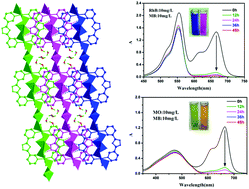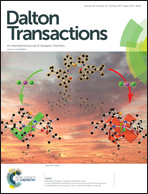Two novel POM-based inorganic–organic hybrid compounds: synthesis, structures, magnetic properties, photodegradation and selective absorption of organic dyes†
Abstract
The hydrothermal reactions of a mixture of (NH4)6Mo7O24·4H2O, Cu(Ac)2·H2O and 3-bpo ligands at different temperatures result in the isolation of two novel inorganic–organic hybrid materials containing different but related isopolymolybdate units, [Cu(3-bpo)(H2O)(Mo4O13)]·3H2O (1) and [Cu2(3-bpo)2(Mo6O20)] (2). The {Mo4O13}n chains in 1 and unprecedented [Mo6O20]4− isopolyhexamolybdate anions in 2 are linked by octahedral Cu2+ ions into two-dimensional hybrid layers. Interestingly, 3-bpo ligands in both 1 and 2 are located on either side of these hybrid layers and serve as arched footbridges to link Cu(II) ions in the layer via pyridyl N-donors, and at the same time connect these hybrid layers into 3D supramolecular frameworks via weak Mo⋯Noxadiazole bonds. Another important point for 1 is that water clusters are filled in the 1D channels surrounded by isopolytetramolybdate units. In addition, dye adsorption and photocatalytic properties of 1 and magnetic properties of 1–2 have been investigated. The results indicated that complex 1 is not only a good heterogeneous photocatalyst in the degradation of methyl orange (MO) and methylene blue (MB), but also has high absorption capacity of MB at room temperature and can selectively capture MB molecules from binary mixtures of MB/MO or MB/RhB. All MB molecules absorbed on 1 can be completely released and photodegraded in the presence of adequate peroxide. The temperature dependence of magnetic susceptibility revealed that complex 2 exhibits antiferromagnetic ordering at about 5 K, and a spin-flop transition was observed at about 5.8 T at 2 K, indicating metamagnetic-like behaviour from antiferromagnetic to ferromagnetic phases.


 Please wait while we load your content...
Please wait while we load your content...